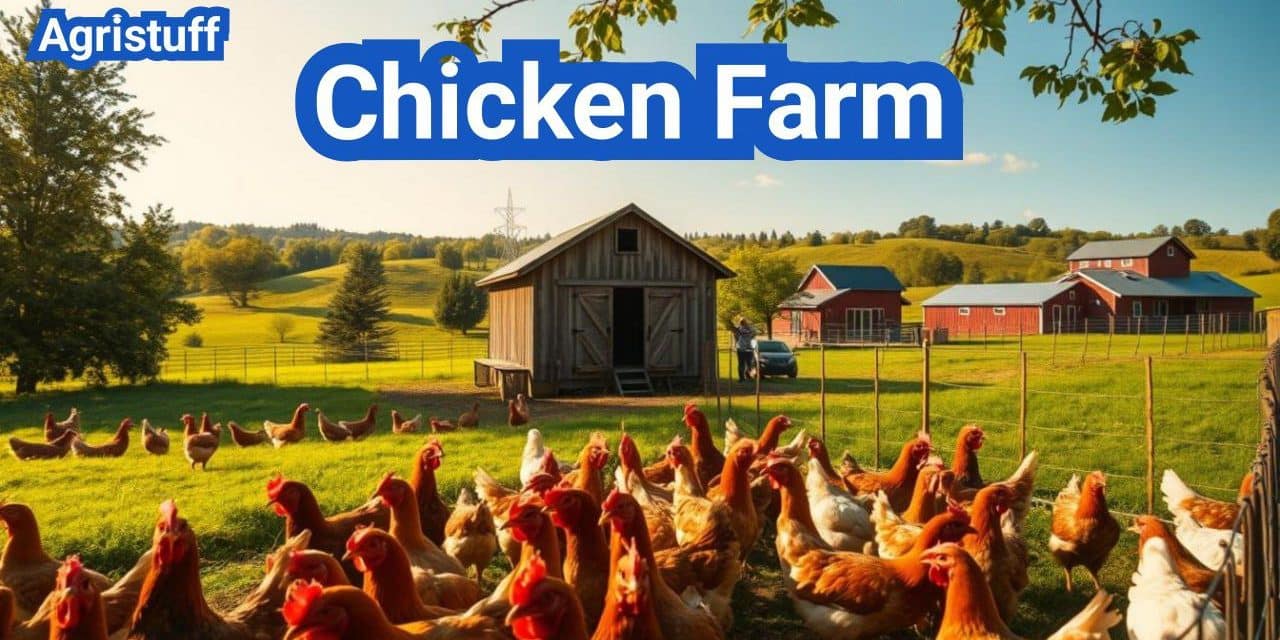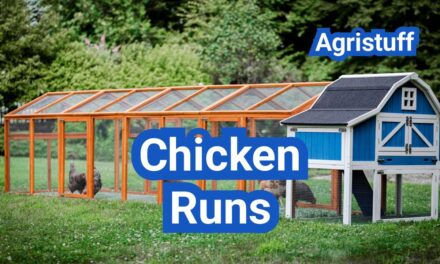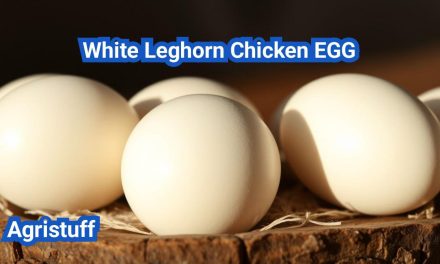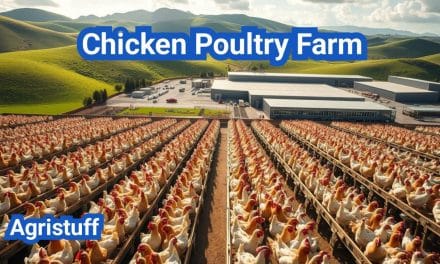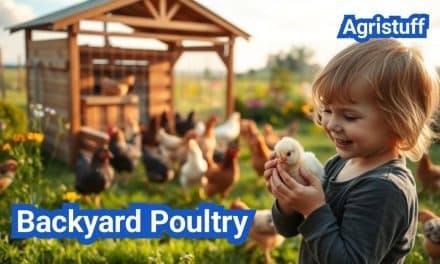Embarking on a chicken farming venture requires careful planning and execution. To ensure success, it’s essential to understand the basics of poultry farming and develop a comprehensive business strategy.
A well-planned chicken farm can be a lucrative business, providing a steady income stream for farmers. By following a step-by-step guide, beginners can navigate the process with ease and establish a thriving operation.
Key Takeaways
- Develop a comprehensive business plan
- Understand local regulations and laws
- Choose the right breed for your farm
- Invest in quality equipment and infrastructure
- Implement effective marketing strategies
Understanding the Chicken Farming Business
Chicken farming is not just about raising birds; it’s a business that demands thorough understanding and planning. A poultry farming business can be one of the most lucrative ventures in the world if managed properly.
Types of Chicken Farms
Chicken farms can be categorized based on their production focus. Some farms specialize in egg production, while others focus on meat production. There are also farms that raise dual-purpose breeds or heritage chickens.
- Egg production farms: These farms concentrate on producing eggs for human consumption.
- Meat production farms: These farms raise chickens specifically for meat production.
- Dual-purpose farms: These farms raise breeds that are suitable for both egg and meat production.
According to industry experts, “The diversity in chicken farming allows farmers to choose a niche that best suits their resources and market demand.”
“The key to success in chicken farming lies in understanding your target market and adapting your production accordingly.”
Market Opportunities in Poultry Farming
The poultry farming industry presents numerous market opportunities. With the increasing demand for protein-rich foods, the market for chicken products is expanding globally.
| Market Segment | Growth Potential | Key Drivers |
|---|---|---|
| Egg Production | Moderate | Increasing health awareness, demand for organic eggs |
| Meat Production | High | Rising demand for affordable protein, growth of fast-food chains |
| Specialty Breeds | High | Growing interest in heritage and organic poultry products |
Challenges and Rewards of Chicken Farming
While chicken farming can be a rewarding business, it also comes with its challenges. Farmers must navigate issues such as disease management, market fluctuations, and regulatory compliance.
Rewards:
- Potential for high returns on investment
- Opportunity to contribute to food security
- Diverse market opportunities
In conclusion, understanding the chicken farming business is crucial for success in this industry. By recognizing the different types of chicken farms, market opportunities, and the challenges and rewards associated with poultry farming, farmers can make informed decisions and build a thriving business.
Researching Before You Start Your Chicken Farm

Research is the foundation upon which a thriving chicken farm is built. Before you start your chicken farm business, you have to make a poultry farming business plan, which is very important for all types of businesses.
Industry Analysis and Market Demand
Conducting an industry analysis helps you understand the current state of the chicken farming industry. This includes analyzing market trends, consumer demand, and competitor activity. Understanding market demand is crucial as it helps you determine the type of chicken products to produce and the potential market size.
For instance, if you’re planning to start an egg production farm, you’ll need to analyze the demand for different types of eggs (conventional, organic, free-range) in your target market. Similarly, for meat production, understanding the demand for various chicken products (whole chickens, chicken breasts, thighs) is essential.
Regulations and Compliance Requirements
Chicken farming is a heavily regulated industry. Understanding the regulations and compliance requirements is vital to avoid legal issues and ensure the smooth operation of your farm. These regulations can include animal welfare standards, environmental protection laws, and food safety regulations.
For example, you may need to comply with regulations related to manure management, biosecurity measures, and labeling requirements for your products. Familiarizing yourself with these regulations will help you plan your farm’s operations and infrastructure accordingly.
Learning from Established Chicken Farmers
One of the best ways to prepare for your chicken farming venture is to learn from established chicken farmers. They can provide valuable insights into the challenges and opportunities in the industry. You can learn about best practices, common pitfalls to avoid, and innovative techniques that have proven successful.
Attending industry conferences, joining poultry farming associations, or participating in online forums can be great ways to connect with experienced farmers and gain knowledge from their experiences.
Developing a Comprehensive Chicken Farm Business Plan
Developing a comprehensive chicken farm business plan is crucial for the success of your poultry venture. A business plan is like a roadmap that guides you through various stages of your business, helping you make informed decisions and achieve your goals.
A well-structured business plan for your chicken farm should include several key components. It serves as a foundation for your operation, outlining your objectives, strategies, and financial projections.
Executive Summary and Farm Vision
The executive summary is a concise overview of your chicken farm business plan. It should capture the essence of your operation, including your mission statement, farm vision, and key objectives. Your farm vision should clearly articulate what you aim to achieve with your chicken farm, whether it’s focused on egg production, meat production, or a combination of both.
Key elements to include in your executive summary:
- Business description
- Mission statement
- Farm vision
- Key objectives
- Unique selling proposition (USP)
Financial Projections and Funding Sources
Financial projections are a critical component of your chicken farm business plan. They should include detailed forecasts of your income, expenses, and cash flow over a specified period. This section helps you understand the financial viability of your operation and identify potential funding needs.
Consider the following when creating financial projections:
- Startup costs
- Ongoing expenses (feed, labor, veterinary care)
- Revenue streams (egg sales, meat sales)
- Break-even analysis
Marketing Strategy for Your Poultry Products
A well-crafted marketing strategy is essential for selling your poultry products effectively. This involves identifying your target market, understanding consumer preferences, and developing strategies to reach potential customers.
Key marketing strategies to consider:
- Direct-to-consumer sales
- Wholesale and retail partnerships
- Online marketing and social media
- Product differentiation
Risk Assessment and Mitigation Strategies
Every chicken farm faces various risks, from disease outbreaks to market fluctuations. Conducting a thorough risk assessment and developing mitigation strategies can help you prepare for potential challenges.
Common risks in chicken farming include:
- Disease outbreaks
- Market price volatility
- Environmental factors (weather, climate change)
- Regulatory changes
By developing a comprehensive chicken farm business plan that includes these key components, you can create a solid foundation for your poultry farming operation and increase your chances of success.
Choosing Your Chicken Farming Niche

Selecting the right chicken farming niche is crucial for the success of your poultry business. The chicken farming industry is diverse, offering various opportunities for farmers to specialize in different areas.
Chicken farming encompasses several niches, including egg production, meat production, and raising dual-purpose or heritage breeds. Each niche has its unique requirements, challenges, and market demands.
Egg Production: Layer Chickens
Egg production is a popular niche in chicken farming, focusing on breeds that are prolific layers. Layer chickens are bred specifically for their ability to produce a high volume of eggs.
Key considerations for egg production:
- Nutrition and feeding strategies for optimal egg production
- Coop design and management to ensure hen welfare
- Marketing strategies for egg sales, including direct-to-consumer and wholesale channels
Meat Production: Broiler Chickens
Meat production, or broiler chicken farming, is another significant niche. Broilers are raised specifically for their meat, requiring different breeding, nutrition, and management practices compared to layer chickens.
Important aspects of broiler chicken farming include:
- Breeding and genetics for fast growth rates
- Nutritional programs tailored for broilers
- Efficient housing and ventilation systems
Dual-Purpose Breeds
Dual-purpose breeds offer a versatile option for farmers, providing both eggs and meat. These breeds are ideal for small-scale or diversified farming operations.
As noted by poultry experts, “Dual-purpose breeds are gaining popularity among backyard farmers and small-scale producers due to their versatility and the growing demand for locally sourced poultry products.”
“The beauty of dual-purpose breeds lies in their ability to provide a steady supply of eggs while also offering a source of meat, making them an excellent choice for farmers looking to diversify their products.”
Heritage and Specialty Breeds
Heritage and specialty breeds are becoming increasingly popular among consumers looking for unique poultry products. These breeds often require specific care and management practices.
A comparison of different chicken farming niches is provided in the table below:
| Niche | Primary Focus | Key Characteristics |
|---|---|---|
| Egg Production | Layer Chickens | High egg yield, specific nutrition |
| Meat Production | Broiler Chickens | Fast growth rate, efficient feeding |
| Dual-Purpose | Both Eggs and Meat | Versatility, balanced production |
| Heritage/Specialty | Unique Breeds | Specific care, unique products |
Selecting the Best Chicken Breeds for Your Farm
Choosing the right chicken breed is crucial for the success of your farm, whether you’re focusing on egg production, meat, or a combination of both. The diverse range of chicken breeds available means that farmers have a wide array of choices to meet their specific needs.
Top Egg-Laying Chicken Breeds
For farms focused on egg production, breeds like the Leghorn and the Rhode Island Red are highly regarded for their high egg-laying capabilities. The Leghorn, known for its white eggs, can produce up to 300 eggs per year. The Rhode Island Red is another prolific layer, producing brown eggs with a similar annual output.
Best Meat-Producing Chicken Breeds
When it comes to meat production, breeds such as the Cornish Cross and the Plymouth Rock are favored for their fast growth rate and high-quality meat. The Cornish Cross is particularly noted for its rapid growth, making it a popular choice for commercial meat production.
Heritage Chickens for Sustainable Farming
Heritage breeds, such as the Buff Cochin and the Silver Laced Wyandotte, are gaining popularity for sustainable farming practices. These breeds are known for their hardiness, foraging ability, and rich flavor profile. They also offer the benefit of being more docile and making good pets.
Specialty Breeds like Silkie Hens
Specialty breeds, including the Silkie Hen, are cherished for their unique characteristics. The Silkie is renowned for its fluffy plumage and friendly demeanor, making it a favorite among backyard chicken keepers and specialty farmers alike.
By understanding the characteristics and benefits of different chicken breeds, farmers can make informed decisions that align with their farm’s goals and production needs.
Setting Up Your Chicken Farm Location

Selecting the ideal location for your chicken farm is a critical decision that impacts the overall success of your poultry farming venture. The location affects various aspects of your farm, from the health and productivity of your chickens to your operational costs and market accessibility.
Land Requirements and Considerations
The amount of land required for a chicken farm varies depending on the scale of your operation and the type of chickens you’re raising. For instance, layer chickens require less space than broilers. A general rule of thumb is to have enough land to accommodate your chicken housing, feed storage, and waste management facilities.
A rural area with proximity to a road is preferable for logistical and transportation purposes. Ensuring your land is well-drained and not prone to flooding is also crucial for maintaining the health of your flock.
Climate and Environmental Factors
The climate and environmental conditions of your chosen location significantly impact your chicken farm’s productivity and sustainability. Chickens are sensitive to extreme temperatures, so a location with moderate temperatures is ideal.
Additionally, consideration should be given to natural ventilation, sunlight exposure, and protection from harsh weather conditions. Implementing measures to mitigate the effects of extreme weather can help ensure the well-being of your chickens.
Proximity to Markets and Suppliers
Being close to your target market can significantly reduce transportation costs and help maintain the freshness of your products. Proximity to suppliers is also beneficial as it can lead to more reliable and timely deliveries of feed and other essential supplies.
| Factor | Importance | Considerations |
|---|---|---|
| Proximity to Markets | High | Reduces transportation costs, ensures freshness |
| Proximity to Suppliers | High | Timely deliveries, reliability |
| Land Availability | High | Space for housing, feed storage, waste management |
Zoning and Legal Considerations
Before finalizing a location, it’s essential to check local zoning laws and regulations regarding poultry farming. Compliance with these regulations is crucial to avoid legal issues and ensure the long-term viability of your farm.
Understanding and adhering to environmental regulations, health standards, and other legal requirements will help you establish a reputable and sustainable chicken farming operation.
Essential Chicken Farming Equipment and Supplies

Setting up a successful chicken farm requires careful planning and investment in the right equipment and supplies. The quality and appropriateness of the equipment directly impact the health, productivity, and profitability of the farm.
Housing and Coop Design Options
A good housing system is very important for your poultry farming business. The coop provides shelter and protection for the chickens, and its design should ensure ease of management, health, and safety for both the chickens and the farmer.
Key considerations for housing and coop design include:
- Space per bird
- Ventilation and airflow
- Protection from predators
- Ease of cleaning and maintenance
Feeding and Watering Systems
Efficient feeding and watering systems are crucial for the health and productivity of chickens. These systems should be designed to minimize waste, ensure easy access to food and water, and reduce labor costs.
| System Type | Features | Benefits |
|---|---|---|
| Automatic Feeders | Programmable feeding times, adjustable feed capacity | Reduces labor, ensures consistent feeding |
| Nipple Watering Systems | Reduces spillage, easy to clean | Improves hygiene, reduces water waste |
Incubation and Brooding Equipment
For farms that breed their own chickens, incubation and brooding equipment are essential. Incubators provide a controlled environment for hatching eggs, while brooders care for the young chicks.
Key features to look for in incubation and brooding equipment include:
- Temperature control
- Humidity management
- Turning mechanisms for eggs
- Monitoring systems for health and development
Processing and Packaging Tools
For farms that process their own poultry products, having the right processing and packaging tools is vital. This includes equipment for slaughtering, cleaning, and packaging eggs or meat.
Investing in the right chicken farming equipment and supplies is a critical step towards establishing a successful and sustainable chicken farming operation.
Building Proper Housing for Your Chicken Farm

A well-designed chicken coop is the backbone of a thriving chicken farm, ensuring the health and safety of your flock. A good housing system not only saves your chickens from danger but also increases your profit in the poultry business.
Coop Design and Space Requirements
When it comes to chicken coop design, several factors need to be considered to ensure the well-being of your chickens. The coop should provide enough space for your chickens to move around comfortably. A general rule of thumb is to allocate at least 3-4 square feet per chicken inside the coop.
- Ensure adequate ventilation to prevent ammonia buildup from manure.
- Provide enough light, either naturally or through artificial lighting.
- Design the coop to be predator-proof.
Ventilation and Temperature Control
Proper ventilation is crucial for maintaining a healthy environment inside the coop. It helps regulate temperature and reduces moisture, which can lead to health issues. Installing vents or windows that can be opened and closed as needed can help achieve this balance.
“Adequate ventilation is key to preventing respiratory problems in chickens.”
Predator Protection Measures
Protecting your flock from predators is a top priority. Using predator protection measures such as hardware cloth instead of chicken wire, securing all openings, and potentially using electric fencing around the coop can significantly reduce risks.
| Predator Protection Measure | Description |
|---|---|
| Hardware Cloth | Strong, durable material that prevents predators from chewing through. |
| Secure Openings | Ensuring all windows and doors are securely locked. |
| Electric Fencing | Deters predators with a non-lethal electric shock. |
Nesting Boxes and Roosting Areas
Nesting boxes are essential for egg-laying hens, providing a safe and comfortable place to lay their eggs. Ensure there is one nesting box per 3-4 hens. Roosting bars should also be provided for chickens to roost at night, keeping them safe from predators and comfortable.
- Place nesting boxes in a quiet, dark area of the coop.
- Use soft bedding material like straw or wood shavings.
- Position roosting bars higher than the nesting boxes.
Sourcing and Raising Healthy Chicks

Sourcing healthy chicks is a critical step in establishing a successful chicken farm. The quality of your chicks directly impacts the overall health and productivity of your flock.
Finding Reputable Hatcheries and Suppliers
To ensure you’re getting healthy chicks, it’s crucial to find reputable hatcheries and suppliers. Look for hatcheries that have a good reputation, follow proper breeding practices, and provide healthy, vaccinated chicks. You can check online reviews, ask for referrals from other farmers, and visit the hatchery in person to assess their operations.
Key factors to consider when selecting a hatchery include:
- The breed and quality of chicks they offer
- Their vaccination protocols
- Feed and care practices
- Customer service and support
Brooding Essentials for Baby Chicks
Brooding is the process of caring for baby chicks until they’re old enough to be moved to the regular chicken coop. Essential brooding equipment includes a brooder, heat lamp, feeder, and waterer. The brooder should be clean, dry, and draft-free, with adequate ventilation.
Proper brooding practices are vital for the health and survival of your chicks. Ensure the brooder is maintained at the right temperature, and monitor the chicks’ behavior to adjust as necessary.
Vaccination and Early Health Management
Vaccination is a critical aspect of early health management for chicks. Consult with a veterinarian to determine the best vaccination schedule for your flock. Additionally, maintaining a clean environment, providing nutritious feed, and ensuring access to fresh water are all crucial for the health and well-being of your chicks.
Early health management practices include:
- Monitoring chick health daily
- Administering vaccinations as recommended
- Providing a nutritious starter feed
- Ensuring access to clean water at all times
Daily Chicken Farm Management Practices

To ensure the health and productivity of chickens, daily farm management is essential. This involves a range of activities that are critical to the overall success of the farm.
Feeding Regimens and Nutrition
Chicken feed can account for up to 70% of the total cost of raising chickens. Therefore, it’s crucial to implement an efficient feeding regimen. This includes selecting the right type of feed for different stages of chicken growth and ensuring that the nutritional needs are met.
Nutritional Requirements for Chickens:
| Age | Feed Type | Nutritional Requirements |
|---|---|---|
| 0-4 weeks | Starter feed | High protein (20-22%) |
| 5-8 weeks | Grower feed | Moderate protein (18-20%) |
| 9 weeks and above | Layer or finisher feed | Specific nutrients for egg production or finishing |
Water Management and Quality Control
Access to clean water is vital for the health of chickens. Daily checks should be performed to ensure that water is fresh and free from contamination. Implementing a regular watering schedule and maintaining the watering system can prevent many health issues.
Cleaning and Waste Management
Regular cleaning of the chicken coop and proper waste management are essential to prevent disease. This includes removing soiled bedding, cleaning feeding and watering equipment, and disposing of waste appropriately.
Best Practices for Cleaning:
- Remove chickens from the coop before cleaning.
- Use appropriate disinfectants.
- Ensure the coop is dry before reintroducing chickens.
Record Keeping and Performance Tracking
Maintaining accurate records is crucial for monitoring the health and productivity of the chickens. This includes tracking feed consumption, egg production, and health issues. Analyzing these records helps in making informed decisions to improve farm management.
Key Records to Keep:
- Feed consumption logs.
- Egg production records.
- Health monitoring logs.
- Vaccination and medication records.
Health Management and Disease Prevention

Chicken farmers must prioritize health management and disease prevention to ensure the sustainability of their operations. Poultry are very sensitive to environmental changes, and if not properly cared for, they can be easily exposed to various bacteria.
Common Poultry Diseases and Symptoms
Poultry diseases can significantly impact farm productivity. Some common diseases include Avian Influenza, Newcastle Disease, and Infectious Bronchitis. Symptoms can range from respiratory issues to sudden death. Understanding these diseases is crucial for effective management.
| Disease | Symptoms | Prevention Measures |
|---|---|---|
| Avian Influenza | Respiratory distress, decreased egg production | Vaccination, strict biosecurity |
| Newcastle Disease | Respiratory issues, neurological symptoms | Vaccination, controlled movement |
| Infectious Bronchitis | Coughing, sneezing, decreased egg production | Vaccination, improved ventilation |
Preventative Health Measures
Preventing disease is more effective than treating it. Measures include vaccination programs, maintaining cleanliness, and ensuring proper nutrition. Regular monitoring of the flock’s health is also essential.
Working with Poultry Veterinarians
Poultry veterinarians play a crucial role in maintaining flock health. They can provide guidance on vaccination programs, diagnose diseases, and recommend treatment protocols. Regular consultations can help prevent outbreaks.
Biosecurity Protocols for Your Farm
Biosecurity is critical in preventing the introduction and spread of diseases. Protocols include controlling access to the farm, using disinfectants, and implementing hygiene practices for staff and visitors.
- Limit farm access to authorized personnel
- Use foot baths and hand sanitizers
- Regularly clean and disinfect equipment and facilities
By implementing these health management strategies, chicken farmers can significantly reduce the risk of disease outbreaks and maintain a healthy, productive flock.
Sustainable and Organic Chicken Farming Practices

As the poultry industry evolves, sustainable and organic chicken farming practices are becoming increasingly important. Consumers are driving this change, seeking more environmentally friendly and ethical food production methods.
Pasture-Raised Poultry Systems
Pasture-raised poultry systems offer numerous benefits, including improved chicken welfare and reduced environmental impact. By allowing chickens to roam outdoors, farmers can promote natural behaviors and reduce the need for antibiotics.
- Improved animal welfare through free-range conditions
- Enhanced biodiversity and ecosystem services
- Potential for improved nutritional quality of poultry products
Organic Certification Requirements
For farmers considering organic certification, understanding the requirements is crucial. Organic certification involves adhering to strict guidelines regarding feed, living conditions, and health management.
“Organic agriculture is a production system that sustains the health of soils, ecosystems, and people.” – IFOAM Organics International
Key aspects include using organic feed, avoiding synthetic fertilizers and pesticides, and ensuring access to the outdoors.
Environmental Impact Management
Managing the environmental impact of chicken farming is critical for sustainability. This includes strategies to reduce waste, conserve water, and protect natural habitats.
Effective environmental management practices include:
- Implementing manure management systems to reduce pollution
- Using renewable energy sources on farms
- Conserving water through efficient systems
Sustainable Feed Options
The choice of feed is a significant factor in the sustainability of chicken farming. Sustainable feed options can reduce the environmental footprint of poultry production.
Some sustainable feed options include:
- Using locally sourced ingredients
- Incorporating alternative protein sources like insects
- Reducing reliance on resource-intensive feed crops
According to the 2010 Assessment of the Environmental Impact of the U.S. Egg Industry, the environmental footprint of one dozen eggs had been reduced by up to 71% over the last 50 years, demonstrating the potential for significant improvements in sustainability.
Marketing and Selling Your Chicken Farm Products
Selling chicken farm products directly to consumers can significantly increase profit margins. For instance, you can earn about $2 to $3 for each crate of smaller eggs and $3-4 for bigger ones, highlighting the potential for substantial revenue through effective marketing strategies.
Direct-to-Consumer Sales Strategies
Direct-to-consumer sales allow farmers to bypass intermediaries and sell products directly to customers, thereby increasing profit margins. Strategies include:
- Establishing a strong online presence through websites and social media platforms.
- Participating in local farmers’ markets to connect with customers.
- Creating a community-supported agriculture (CSA) program.
As noted by a successful farmer,
“Direct sales not only increase our revenue but also help us build a loyal customer base.”
Wholesale and Retail Partnerships
Building partnerships with wholesalers and retailers is another effective strategy for marketing chicken farm products. This involves:
- Identifying potential partners who align with your brand values.
- Negotiating contracts that ensure fair pricing and consistent demand.
- Maintaining high-quality products to meet the partners’ standards.
Developing strong relationships with wholesalers and retailers can lead to long-term contracts and stable revenue streams.
Building Your Farm Brand
Creating a strong brand identity is crucial for differentiating your products in a competitive market. This includes:
- Developing a unique brand story and visual identity.
- Implementing consistent branding across all marketing channels.
- Engaging with customers through storytelling and transparency.
Brand loyalty can be fostered by providing high-quality products and exceptional customer service.
Value-Added Products to Increase Profitability
Creating value-added products is a strategy to increase profitability by processing raw products into more refined goods. Examples include:
| Product | Description | Potential Price Increase |
|---|---|---|
| Eggs | Packaged in cartons with custom branding | 20-30% |
| Chicken Meat | Processed into sausages or marinated products | 50-100% |
Value-added products not only command higher prices but also help in diversifying your product offerings, thereby attracting a wider customer base.
Keys to Chicken Farm Success
Achieving chicken farm success requires careful planning, efficient management, and a deep understanding of the poultry farming business. As highlighted throughout this guide, selecting the right chicken breeds, setting up proper housing, and implementing effective health management practices are crucial steps toward a thriving farm.
Poultry farming is one of the most profitable businesses today, offering numerous opportunities for entrepreneurs. By focusing on sustainable practices, developing a robust marketing strategy, and maintaining high standards of animal welfare, farmers can ensure long-term success and profitability.
The keys to success in chicken farming lie in meticulous daily management, continuous learning, and adapting to changes in market demand and environmental conditions. By following the strategies outlined in this guide, new and experienced farmers alike can achieve their goals and enjoy a rewarding career in chicken farming.
FAQ
What are the key elements to consider when starting a chicken farm?
When starting a chicken farm, it’s essential to consider developing a comprehensive business plan, researching the industry, and understanding market demand, regulations, and compliance requirements.
What are the different types of chicken farms, and how do I choose the right one?
The main types of chicken farms are egg production, meat production, dual-purpose breeds, and heritage or specialty breeds. To choose the right one, consider your resources, market demand, and the level of care you’re willing to provide.
How do I select the best chicken breeds for my farm?
To select the best chicken breeds, consider factors like egg-laying ability, meat production, climate hardiness, and disease resistance. Research top breeds for your chosen niche, such as Leghorns for egg production or Cornish Cross for meat production.
What are the essential equipment and supplies needed for chicken farming?
Essential equipment includes housing and coop design, feeding and watering systems, incubation and brooding equipment, and processing and packaging tools. The specific equipment needed will depend on the size and type of your operation.
How can I ensure the health and well-being of my chickens?
To ensure the health and well-being of your chickens, implement proper feeding regimens, water management, cleaning and waste management, and record keeping. Regularly inspect your flock for signs of disease and work with a poultry veterinarian to develop a health management plan.
What are some sustainable and organic chicken farming practices I can adopt?
Sustainable and organic practices include pasture-raised systems, organic certification, environmental impact management, and sustainable feed options. These practices can help reduce your farm’s environmental footprint and appeal to consumers seeking eco-friendly products.
How can I market and sell my chicken farm products effectively?
To market and sell your products effectively, consider direct-to-consumer sales strategies, wholesale and retail partnerships, building your farm brand, and creating value-added products. Develop a marketing plan that highlights the unique qualities of your products and appeals to your target audience.
What are some common challenges faced by chicken farmers, and how can I overcome them?
Common challenges include disease management, predator protection, and market fluctuations. To overcome these challenges, stay informed about best practices, develop a comprehensive business plan, and be prepared to adapt to changing circumstances.
How can I ensure compliance with regulations and laws governing chicken farming?
To ensure compliance, research local, state, and federal regulations governing chicken farming, including zoning laws, environmental regulations, and animal welfare standards. Consult with relevant authorities and industry experts to ensure you’re meeting all necessary requirements.
What are some key performance indicators (KPIs) I should track on my chicken farm?
Key performance indicators include flock health, egg production or meat yield, feed conversion ratios, and mortality rates. Regularly tracking these KPIs will help you identify areas for improvement and optimize your farm’s performance.
Conclusion Of: Chicken Farm
Starting a chicken farm is a rewarding business venture offering opportunities for financial independence and sustainability. A chicken farm provides fresh eggs, nutritious meat, and even enjoyable companionship. In the United States, chicken farms contribute significantly to agriculture, offering employment and food security. Learn more about poultry farming’s economic impact from the USDA.
Why Start a Chicken Farm
Starting a chicken farm is appealing due to its relatively low startup cost, rapid growth potential, and strong market demand. The chicken farm industry is stable, continuously growing, and offers excellent opportunities for profitability. Explore poultry industry trends from the National Chicken Council.
Choosing the Right Location
Selecting an appropriate location for your chicken farm is essential. Consider land availability, accessibility, water sources, and proximity to markets. A well-chosen location enhances productivity and reduces operating costs. Read about site selection from Penn State Extension.
Selecting Chicken Breeds
Choosing the right breeds is fundamental when starting a chicken farm. Popular breeds for egg production include Rhode Island Reds and Leghorns, while Cornish Cross and Jersey Giants are excellent choices for meat production. Compare poultry breeds with the University of Georgia’s Poultry Science Department.
Housing and Infrastructure
Proper housing is crucial for a successful chicken farm. The housing must be secure, well-ventilated, adequately spacious, and safe from predators and extreme weather conditions. Get coop design tips from Mississippi State University Extension.
Essential Equipment
Investing in quality equipment is vital for an efficient chicken farm operation. Essential items include feeders, drinkers, nesting boxes, incubators, heaters, and proper lighting systems. Review equipment recommendations from the University of Arkansas.
Feeding and Nutrition
Nutrition is key to maintaining a healthy chicken farm. Chickens require balanced diets comprising grains, protein, vitamins, and minerals to ensure optimal growth and productivity. Learn about poultry nutrition from the FDA.
Maintaining Chicken Health
Health management is critical to your chicken farm’s success. Regular vaccinations, proper sanitation, routine inspections, and timely veterinary care help maintain a healthy flock and prevent disease outbreaks. Check biosecurity guidelines from the CDC.
Breeding and Chick Management
Efficient breeding practices and chick management significantly impact your chicken farm’s productivity. Effective incubation methods, brooding techniques, and chick care strategies are crucial for sustainable growth. Study best practices from the University of Florida IFAS.
Egg Production and Management
For chicken farms focusing on egg production, understanding the laying cycle, managing nests, and timely egg collection enhances efficiency and maximizes profits. Read egg farming insights from Iowa State University.
Meat Production Practices
If your chicken farm targets meat production, focusing on growth rates, feed conversion efficiency, and humane processing practices ensures high-quality poultry meat. Explore broiler farming from the University of Kentucky.
Financial Planning
Effective financial planning and budgeting are essential for a profitable chicken farm. Proper financial management involves tracking expenses, revenues, and overall profitability. Access farm budgeting tools from USDA’s Farm Service Agency.
Marketing Strategies
Efficient marketing is crucial for chicken farm success. Utilize local markets, direct consumer sales, and digital platforms to expand your customer base and increase revenue. Discover agri-marketing tips from Purdue Extension.
Legal and Regulatory Compliance
Compliance with local and federal regulations ensures your chicken farm operates legally and sustainably. Understanding relevant laws and obtaining necessary permits is essential. See poultry farming regulations from the FDA.
Avoiding Common Mistakes
When starting a chicken farm, beginners often face challenges such as inadequate space, poor biosecurity, and improper feeding practices. Planning and education help prevent these common pitfalls. Learn from common poultry farming mistakes via the University of Maryland Extension.
Sustainable Chicken Farming
Adopting sustainable practices enhances your chicken farm’s longevity and environmental benefits. Effective waste management, resource conservation, and environmentally friendly farming practices are recommended. Explore sustainable farming from the EPA.
Expanding Your Chicken Farm
As your chicken farm becomes established, explore expansion opportunities such as diversifying products, adopting advanced technologies, or increasing flock size. Get scaling advice from the Small Business Administration.
Final Thought
Starting a chicken farm requires thorough planning, informed decisions, and consistent effort. Following this comprehensive guide ensures beginners establish a successful and profitable chicken farming venture. For further reading, visit the USDA’s Poultry Production Resources.

